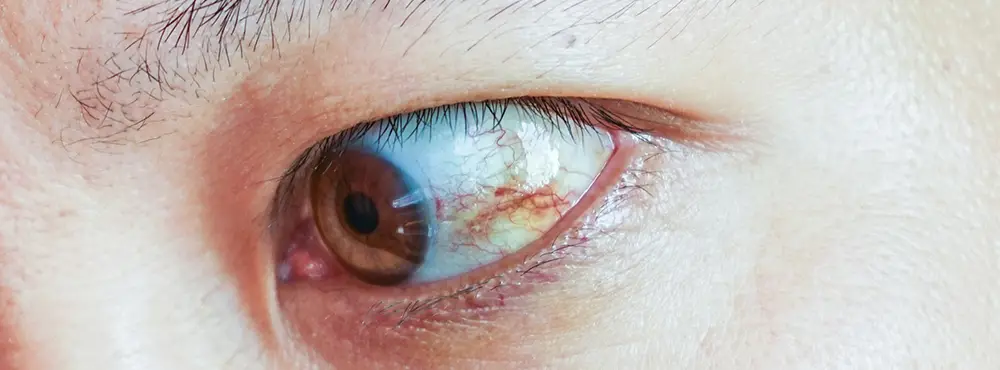Different eye infections have different causes and treatments. Eye infections are common and easily treatable, and most people will suffer from at least one in their lifetime. They can infect the eyelids, the cornea and the retina at the back of the eye.
What are eye infections?
Eye infections are typically caused by bacterial, viral or fungal organisms that find their way into the eye.
Infections can occur in one or both eyes, and occur at any time, regardless of age or background. Conjunctivitis (pink eye) is the most common eye infection that affects people. Trachoma is an eye infection affecting both eyes caused by a bacterium called Chlamydia trachomatis. It is more common in underdeveloped countries and is the world’s leading cause of infectious blindness.
What causes eye infections?
Eye infections are either bacterial, fungal, or viral. Anytime dirty or unsanitised substances enter the eye, a potential eye infection can occur.
Bad hand hygiene whilst wearing contact lenses can also lead to eye infections.
Can Covid start with eye infection?
COVID-19 can cause an eye infection known as conjunctivitis; however, this is very rare and the most common symptoms of COVID-19 are a fever, coughing and difficulty breathing.
Symptoms of an eye infection?
You can tell if your eye is infected based on the way it looks and feels. Common symptoms of an eye infection include:
- Pain
- Itching
- Irritation
- Light sensitivity
- A burning sensation
- Twitching
- Excessive tearing
- Tender eyelids
- A small painful bump at the base of your eyelashes
- A feeling of something being in your eye
You may also find that you have blurry vision, develop a fever or swollen lymph nodes near your ear.
What does an eye infection look like?
An eye infection can present itself in many ways and cause changes to your eyes appearance. You may have:
- Red or purple eyelids that look swollen
- Discharge coming out of your eyes
- Crusting around the eyelashes or eyelids
- Pink colouration in the whites of your eyes
If you experience any of the above symptoms, you should contact your eye care specialist immediately for an eye exam or go straight to your doctor. An eye exam will be able to identify various eye conditions to prevent future eye problems such as permanent vision loss.
How do you treat an eye infection?
Your doctor may take a culture sample from the affected area so that they can determine the type of infection and the most effective treatment.
Antibiotics, antiviral medications, antibiotic eye drops, creams or cold or hot compresses are all common treatments for eye infections.
Severe infections such as acanthamoeba keratitis will need more aggressive treatments. Infections caused by viruses will need antiviral therapy.
If you wear contact lenses, we advise you to change to glasses until you have visited your optician or GP for a diagnosis. They will identify different types of eye infections and prescribe the best treatment.
What are common infections of the eye?
Below are some examples of common eye infections:
Conjunctivitis
Infectious conjunctivitis is usually the result of a viral or bacterial infection. It is highly contagious and often spread in classroom environments.
Babies can also contract conjunctival eye infections at birth if the mother has a sexually transmitted disease. Gonococcal and chlamydial conjunctivitis are both examples of these.
Aside from common conjunctivitis, ocular herpes is another example of a viral eye infection.
Stye
This is a painful red bump under your eyelid or at the base of your lashes. They appear when bacteria infect the oil glands in these areas.
Uveitis
Uveitis is an inflammation of the uvea, the middle layer of the eye. It is associated with autoimmune disorders such as rheumatoid arthritis or lupus. However, it can also be caused by certain viruses, including herpes.
Herpes simplex
This is a severe eye infection caused when the virus reactivates and spreads to the eye. It can be caused by a weakened immune system, eye injury, stress, periods, illness, and a high temperature.
If appropriately treated, herpes simplex eye infections are unlikely to cause further problems. However, more severe cases can cause scarring of the cornea, glaucoma (when there is damage to the optic nerve), another eye infection and permanent vision loss.
Trachoma
This severe eye infection is related to Chlamydia trachomatis and is spread by flies in environments with poor hygiene.
Endophthalmitis
This is usually caused by penetration to the eye from an eye injury. As a result, bacteria can infect the inside of the eye.
Fungal keratitis
This fungal eye infection is associated with Fusarium fungi which are found in organic matter. These fungi can also cause eye infections in other ways such as through eye injury caused by a tree branch.
Blepharitis
Blepharitis is an inflammation of the eyelids. It can affect both eyes and is caused by bacterial infections, allergies, clogged oil glands in the eyelids, and certain skin conditions.
Eye infection complications
Eye infections can cause complications such as cellulitis. There are two types of cellulitis which may affect the eyes:
- Preseptal cellulitis – this type affects the eyelids.
- Orbital cellulitis – this type affects the eyeball or causes swelling of the eye or eyelid. Orbital cellulitis can lead to vision loss and/or meningitis and is life-threatening if not treated properly.
An eye infection can also cause dacryocystitis, which is when the eye's tear drainage system becomes inflamed or blocked.
Another complication of eye infections is a corneal ulcer which can lead to severe vision loss.
Will an eye infection go away by itself?
Some eye infections are less problematic than others and can go away by themselves. Conjunctivitis, for example, can clear up without any treatment, especially if it is mild. However, if symptoms persist, visit your optician or GP.
How can you avoid eye infections?
Some infections spread relatively quickly from person to person; you should be careful around others who have infections. Avoid getting to close to their face, or handling the same items until the infection has cleared.
You can also minimise the risk of an eye infection by:
- Washing your hands frequently throughout the day
- Avoiding rubbing your eyes
- Making sure your towels and bed linens are clean
- Cleaning surfaces with anti-bacterial cleaning products
When wearing contact lenses, make sure to wash your hands whilst removing, inserting and cleaning your lenses. With the exception of extended wear lenses, (which can be worn continuously up to a week) avoid wearing lenses for longer than 12 hours a day. We recommend consulting with an optometrist before wearing extended wear lenses to discuss whether your eyes can tolerate them.
Quick links:
A guide to conjunctivitis
A guide to red eyes
A guide to itchy eyes
Disclaimer: The advice in this article is for informational purposes only and does not replace medical care or an in-person check-up. Please check with an eyecare professional before purchasing any products or remedies. For information on our article review process, please refer to our Editorial Policy.

 Offers
Offers Account
Account
 Favorite
Favorite
 Basket
Basket

 OFFERS
OFFERS
















